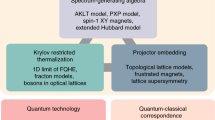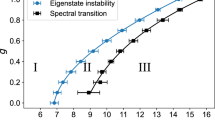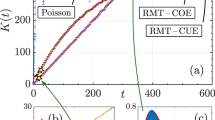Abstract
The thermodynamic description of many-particle systems rests on the assumption of ergodicity, the ability of a system to explore all allowed configurations in the phase space. Recent studies on many-body localization have revealed the existence of systems that strongly violate ergodicity in the presence of quenched disorder. Here, we demonstrate that ergodicity can be weakly broken by a different mechanism, arising from the presence of special eigenstates in the many-body spectrum that are reminiscent of quantum scars in chaotic non-interacting systems. In the single-particle case, quantum scars correspond to wavefunctions that concentrate in the vicinity of unstable periodic classical trajectories. We show that many-body scars appear in the Fibonacci chain, a model with a constrained local Hilbert space that has recently been experimentally realized in a Rydberg-atom quantum simulator. The quantum scarred eigenstates are embedded throughout the otherwise thermalizing many-body spectrum but lead to direct experimental signatures, as we show for periodic recurrences that reproduce those observed in the experiment. Our results suggest that scarred many-body bands give rise to a new universality class of quantum dynamics, opening up opportunities for the creation of novel states with long-lived coherence in systems that are now experimentally realizable.
This is a preview of subscription content, access via your institution
Access options
Access Nature and 54 other Nature Portfolio journals
Get Nature+, our best-value online-access subscription
$29.99 / 30 days
cancel any time
Subscribe to this journal
Receive 12 print issues and online access
$209.00 per year
only $17.42 per issue
Buy this article
- Purchase on Springer Link
- Instant access to full article PDF
Prices may be subject to local taxes which are calculated during checkout




Similar content being viewed by others
References
Kinoshita, T., Wenger, T. & Weiss, D. S. A quantum Newton’s cradle. Nature 440, 900–903 (2006).
Schreiber, M. et al. Observation of many-body localization of interacting fermions in a quasirandom optical lattice. Science 349, 842–845 (2015).
Smith, J. et al. Many-body localization in a quantum simulator with programmable random disorder. Nat. Phys. 12, 907–911 (2016).
Kucsko, G. et al. Critical thermalization of a disordered dipolar spin system in diamond. Preprint at http://arxiv.org/abs/1609.08216 (2016).
Sutherland, B. Beautiful Models: 70 Years of Exactly Solved Quantum Many-body Problems (World Scientific, River Edge, NJ, 2004).
Basko, D., Aleiner, I. & Altshuler, B. Metal–insulator transition in a weakly interacting many-electron system with localized single-particle states. Ann. Phys. 321, 1126–1205 (2006).
Serbyn, M., Papić, Z. & Abanin, D. A. Local conservation laws and the structure of the many-body localized states. Phys. Rev. Lett. 111, 127201 (2013).
Huse, D. A., Nandkishore, R. & Oganesyan, V. Phenomenology of fully many-body-localized systems. Phys. Rev. B 90, 174202 (2014).
Deutsch, J. M. Quantum statistical mechanics in a closed system. Phys. Rev. A. 43, 2046 (1991).
Srednicki, M. Chaos and quantum thermalization. Phys. Rev. E 50, 888–901 (1994).
Rigol, M., Dunjko, V., Yurovsky, V. & Olshanii, M. Relaxation in a completely integrable many-body quantum system: An ab initio study of the dynamics of the highly excited states of 1D lattice hard-core bosons. Phys. Rev. Lett. 98, 050405 (2007).
Rigol, M., Dunjko, V. & Olshanii, M. Thermalization and its mechanism for generic isolated quantum systems. Nature 452, 854–858 (2008).
Kim, H., Ikeda, T. N. & Huse, D. A. Testing whether all eigenstates obey the eigenstate thermalization hypothesis. Phys. Rev. E 90, 052105 (2014).
Read, N. & Rezayi, E. Beyond paired quantum Hall states: Parafermions and incompressible states in the first excited Landau level. Phys. Rev. B 59, 8084–8092 (1999).
Feiguin, A. et al. Interacting anyons in topological quantum liquids: The Golden Chain. Phys. Rev. Lett. 98, 160409 (2007).
Lesanovsky, I. & Katsura, H. Interacting Fibonacci anyons in a Rydberg gas. Phys. Rev. A.86, 041601 (2012).
Lindner, N. H., Berg, E., Refael, G. & Stern, A. Fractionalizing Majorana fermions: Non-Abelian statistics on the edges of Abelian quantum Hall states. Phys. Rev. X 2, 041002 (2012).
Glaetzle, A. W. et al. Quantum spin-ice and dimer models with Rydberg atoms. Phys. Rev. X 4, 041037 (2014).
Vasseur, R., Potter, A. C. & Parameswaran, S. A. Quantum criticality of hot random spin chains. Phys. Rev. Lett. 114, 217201 (2015).
Chandran, A., Schulz, M. D. & Burnell, F. J. The eigenstate thermalization hypothesis in constrained Hilbert spaces: A case study in non-Abelian anyon chains. Phys. Rev. B 94, 235122 (2016).
Lan, Z. & Powell, S. Eigenstate thermalization hypothesis in quantum dimer models. Phys. Rev. B 96, 115140 (2017).
Lan, Z., van Horssen, M., Powell, S. & Garrahan, J. P. Quantum slow relaxation and metastability due to dynamical constraints. Preprint at http://arxiv.org/abs/1706.02603 (2017).
Schauß, P. et al. Observation of spatially ordered structures in a two-dimensional Rydberg gas. Nature 491, 87–91 (2012).
Labuhn, H. et al. Tunable two-dimensional arrays of single Rydberg atoms for realizing quantum Ising models. Nature 534, 667–670 (2016).
Bernien, H. et al. Probing many-body dynamics on a 51-atom quantum simulator. Nature 551, 579–584 (2017).
Heller, E. J. Bound-state eigenfunctions of classically chaotic Hamiltonian systems: Scars of periodic orbits. Phys. Rev. Lett. 53, 1515–1518 (1984).
Sridhar, S. Experimental observation of scarred eigenfunctions of chaotic microwave cavities. Phys. Rev. Lett. 67, 785–788 (1991).
Marcus, C. M., Rimberg, A. J., Westervelt, R. M., Hopkins, P. F. & Gossard, A. C. Conductance fluctuations and chaotic scattering in ballistic microstructures. Phys. Rev. Lett. 69, 506–509 (1992).
Sun, B. & Robicheaux, F. Numerical study of two-body correlation in a 1D lattice with perfect blockade. New. J. Phys. 10, 045032 (2008).
Vidal, G. Classical simulation of infinite-size quantum lattice systems in one spatial dimension. Phys. Rev. Lett. 98, 070201 (2007).
Lesanovsky, I. Liquid ground state, gap, and excited states of a strongly correlated spin chain. Phys. Rev. Lett. 108, 105301 (2012).
Moudgalya, S., Rachel, S., Bernevig, B. A. & Regnault, N. Exact excited states of non-integrable models. Preprint at http://arxiv.org/abs/1708.05021 (2017).
Fendley, P., Sengupta, K. & Sachdev, S. Competing density-wave orders in a one-dimensional hard-boson model. Phys. Rev. B 69, 075106 (2004).
Fendley, P. Strong zero modes and eigenstate phase transitions in the XYZ/interacting Majorana chain. J. Phys. A 49, 30LT01 (2016).
Berry, M. V. & Tabor, M. Level clustering in the regular spectrum. Proc. R. Soc. A 356, 375–394 1977).
Pal, A. & Huse, D. A. Many-body localization phase transition. Phys. Rev. B 82, 174411 (2010).
Bogomolny, E. B., Gerland, U. & Schmit, C. Models of intermediate spectral statistics. Phys. Rev. E 59, R1315–R1318 (1999).
Carleo, G., Becca, F., Schiró, M. & Fabrizio, M. Localization and glassy dynamics of many-body quantum systems. Sci. Rep. 2, 243 (2012).
De Roeck, W. & Huveneers, F. Asymptotic quantum many-body localization from thermal disorder. Commun. Math. Phys. 332, 1017–1082 (2014).
Schiulaz, M. & Müller, M. Ideal quantum glass transitions: Many-body localization without quenched disorder. AIP Conf. Proc. 1610,11–23 (2014).
Yao, N. Y., Laumann, C. R., Cirac, J. I., Lukin, M. D. & Moore, J. E. Quasi-many-body localization in translation-invariant systems. Phys. Rev. Lett.117, 240601 (2016).
van Horssen, M., Levi, E. & Garrahan, J. P. Dynamics of many-body localization in a translation-invariant quantum glass model. Phys. Rev. B 92, 100305 (2015).
Veness, T., Essler, F. H. L. & Fisher, M. P. A. Quantum disentangled liquid in the half-filled Hubbard model. Phys. Rev. B 96, 195153 (2017).
Kim, I. H. & Haah, J. Localization from superselection rules in translationally invariant systems. Phys. Rev. Lett. 116, 027202 (2016).
Yarloo, H., Langari, A. & Vaezi, A. Anyonic self-induced disorder in a stabilizer code: Quasi many-body localization in a translational invariant model. Phys. Rev. B 97, 054304 (2018).
Michailidis, A. A. et al. Slow dynamics in translation-invariant quantum lattice models. Phys. Rev. B 97, 104307 (2018).
Smith, A., Knolle, J., Moessner, R. & Kovrizhin, D. L. Absence of ergodicity without quenched disorder: From quantum disentangled liquids to many-body localization. Phys. Rev. Lett. 119, 176601 (2017).
Brenes, M., Dalmonte, M., Heyl, M. & Scardicchio, A. Many-body localization dynamics from gauge invariance. Phys. Rev. Lett. 120, 030601 (2018).
Bloch, I., Dalibard, J. & Nascimbène, S. Quantum simulations with ultracold quantum gases. Nat. Phys. 8, 267–276 (2012).
Blatt, R. & Roos, C. F. Quantum simulations with trapped ions. Nat. Phys. 8, 277–284 (2012).
Lanczos, C. An iteration method for the solution of the eigenvalue problem of linear differential and integral operators. J. Res. Natl Bur. Stand. 45, 255–282 (1950).
Sutherland, B. Localization of electronic wave functions due to local topology. Phys. Rev. B 34, 5208–5211 (1986).
Inui, M., Trugman, S. A. & Abrahams, E. Unusual properties of midband states in systems with off-diagonal disorder. Phys. Rev. B 49, 3190–3196 (1994).
Sutherland, B. Exact results for a quantum many-body problem in one dimension. Phys. Rev. A. 4, 2019–2021 (1971).
Bernevig, B. A. & Haldane, F. D. M. Model fractional quantum Hall states and Jack polynomials. Phys. Rev. Lett. 100, 246802 (2008).
Acknowledgements
We acknowledge insightful discussions with M. Lukin and W.W. Ho. C.J.T., A.M. and Z.P. acknowledge support from EPSRC grants EP/P009409/1 and EP/M50807X/1, and Royal Society Research Grant RG160635. D.A. acknowledges support from the Swiss National Science Foundation. This work was initiated during ‘Conference on Many-Body-Localization: Advances in the Theory and Experimental Progress’ at ICTP Trieste.
Author information
Authors and Affiliations
Contributions
All authors contributed to developing the ideas, analysing the results and writing the manuscript. C.J.T., A.A.M. and M.S. performed the numerical simulations.
Corresponding author
Ethics declarations
Competing interests
The authors declare no competing interests.
Additional information
Publisher’s note: Springer Nature remains neutral with regard to jurisdictional claims in published maps and institutional affiliations.
Supplementary information
Supplementary Information
Supplementary notes, Supplementary figures, Supplementary references
Rights and permissions
About this article
Cite this article
Turner, C.J., Michailidis, A.A., Abanin, D.A. et al. Weak ergodicity breaking from quantum many-body scars. Nature Phys 14, 745–749 (2018). https://doi.org/10.1038/s41567-018-0137-5
Received:
Accepted:
Published:
Issue Date:
DOI: https://doi.org/10.1038/s41567-018-0137-5
This article is cited by
-
Preparing random states and benchmarking with many-body quantum chaos
Nature (2023)
-
Trimer quantum spin liquid in a honeycomb array of Rydberg atoms
Communications Physics (2023)
-
Many-body quantum chaos in stroboscopically-driven cold atoms
Communications Physics (2023)
-
Reviving product states in the disordered Heisenberg chain
Nature Communications (2023)
-
Quantum simulation of fundamental particles and forces
Nature Reviews Physics (2023)



